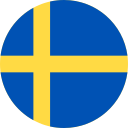

(tiden)
tid
the quantity that is measured in seconds, minutes, hours, etc. using a device like clock


(dygn)
dag
a period of time that is made up of twenty-four hours


(månadens)
månad
each of the twelve named divisions of the year, like January, February, etc.


(kalenderår)
år
a period of time that is made up of twelve months, particularly one that starts on January first and ends on December thirty-first


(veckor)
vecka
a period of time that is made up of seven days in a calendar

(tio dagar)
femtondagarsperiod
a period consisting of two weeks or 14 days


(stund)
timme
each of the twenty-four time periods that exist in a day and each time period is made up of sixty minutes


(minute)
minut
each of the sixty parts that creates one hour and is made up of sixty seconds


N/A
the standard SI unit of time, equal to one-sixtieth of a minute
Grammatiska Information:


(hundradet)
århundrade
a period of one hundred years


(helgdag)
söndag
the day that comes after Saturday
Grammatiska Information:


(måndagar)
måndag
the day that comes after Sunday
Grammatiska Information:


(onsdags)
onsdag
the day that comes after Tuesday
Grammatiska Information:


(torsdagen)
torsdag
the day that comes after Wednesday
Grammatiska Information:


(Fredagen)
Fredag
the day that comes after Thursday
Grammatiska Information:


(lördagar)
lördag
the day that comes after Friday
Grammatiska Information:


(weekend)
helg
the days of the week, usually Saturday and Sunday, when people do not have to go to work or school


(förmiddag)
morgon
the time of day that is between when the sun starts to rise and the middle of the day at twelve o'clock


(måltid)
eftermiddag
the time of day that is between twelve o'clock and the time that the sun starts to set


(afton)
kväll
the time of day that is between the time that the sun starts to set and when the sky becomes completely dark


(period)
säsong
a period of the year during which a particular style of clothes, hair, etc. is in trend
A season is a time of the year characterized by specific weather patterns and changes in nature, and it often influences the types of clothes people wear. For example, during the spring and summer seasons, lighter and brighter clothing is often in trend, as these seasons are associated with warmer weather and longer daylight hours. In contrast, during the fall and winter seasons, darker and warmer clothing is often in trend, as these seasons are associated with cooler weather and shorter daylight hours. However, fashion trends can vary by region and personal preferences, so it's important to consider individual style and comfort when selecting clothing for any season.


(den första månaden)
januari
the first month of the year, after December and before February
Grammatiska Information:


(februari månad)
februari
the second month of the year, after January and before March
Grammatiska Information:


(månad mars)
mars
the third month of the year, after February and before April
Grammatiska Information:


(månaden april)
april
the fourth month of the year, after March and before May
Grammatiska Information:


(må)
kan
used to show the possibility of something happening or being the case
Grammatiska Information:


(månaden juni)
juni
the sixth month of the year, after May and before July
Grammatiska Information:


(månaden juli)
juli
the seventh month of the year, after June and before August
Grammatiska Information:


(månad augusti)
augusti
the eighth month of the year, after July and before September
Grammatiska Information:


(septembermånad)
september
the ninth month of the year, after August and before October
Grammatiska Information:


(den tionde månaden)
oktober
the tenth month of the year, after September and before November
Grammatiska Information:


(nov)
november
the 11th month of the year, after October and before December
Grammatiska Information:


(decembermånad)
december
the 12th and last month of the year, after November and before January
Grammatiska Information:


(saison våren)
vår
the season that comes after winter, when in most countries the trees and flowers begin to grow again


(sommarperiod)
sommar
the season that comes after spring and in most countries summer is the warmest season


(autumn)
höst
the season after summer and before winter when the leaves change color and fall from the trees


N/A
the 24-hour period immediately preceding the current day


(innan)
före
ahead of something else in a sequence or order
Grammatiska Information:

(skottår (noun))
skottår
a year in every four years that has 366 days instead of 365
Grammatiska Information:


(denna dag)
idag
the day that is happening right now


(i morgon)
imorgon
the day that will come after today ends
Grattis! !
Du har lärt dig 41 ord av undefined. För att förbättra inlärningen och granskningen av ordlista, börja träna!
Recension
Flashcards
Stavning
Quiz
